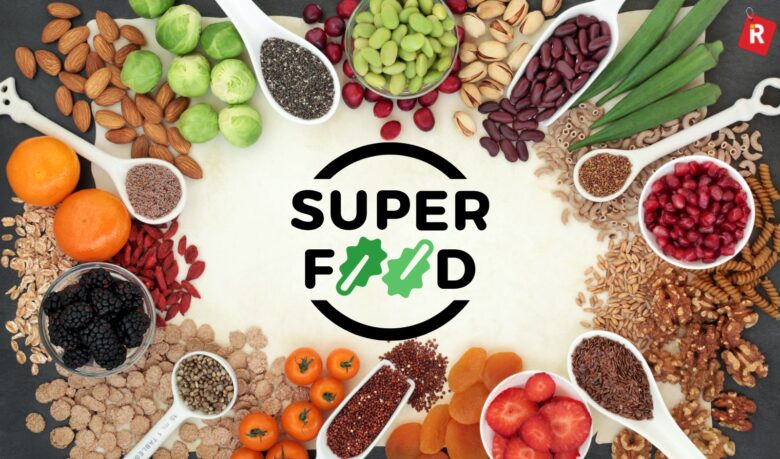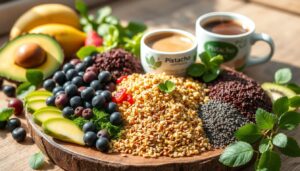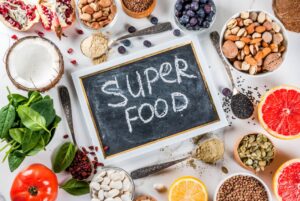Eating well doesn’t have to cost a fortune. When people hear the word “superfood,” they often think of expensive or rare foods. However, there are many easy-to-find, inexpensive options that are also incredibly healthy and affordable. Eating these nutrient-rich foods daily can improve your overall health, give you more energy, and prevent chronic diseases. We’ll discuss some of the most affordable superfoods, how to incorporate them into your diet, and why you should buy them for your health.
What does “affordable” mean when it comes to superfoods?
The high nutritional value of superfoods means they’re rich in vitamins, minerals, enzymes, and other beneficial compounds. Affordability, on the other hand, means these foods are easy to find, affordable, and don’t come at the expense of quality or health benefits. Many inexpensive superfoods are grown locally, require minimal processing, and can be purchased fresh, frozen, or dried, making them ideal for everyday eating.
List of 7 Best Affordable Superfoods and Their Benefits:
1. Lentils and Beans
Beans and lentils are incredibly healthy because they’re rich in plant-based protein, fiber, iron, and calcium. Oats are a staple in many households worldwide because they’re inexpensive, versatile, and shelf-stable. Fiber helps the body digest food and regulate blood sugar levels, while protein aids muscle repair and promotes fullness.
2. Oats
Oats are high in soluble fiber, particularly beta-glucan, which helps lower cholesterol and maintain a healthy heart. Oats are also rich in complex carbohydrates, which provide a slow-burning energy source. You can bake with oats or use them in soups and breakfast dishes.
3. Carrots
Carrots are an inexpensive food rich in beta-carotene. Beta-carotene is an antioxidant that the body converts into vitamin A, which is essential for healthy vision, skin, and a healthy immune system. Carrots are easy to cook and store, and they can also add a crunchy or sweet flavor to dishes.
4. Broccoli
Cabbage is an inexpensive cruciferous vegetable, rich in fiber, vitamins C and K, and chemicals that may help prevent cancer. It can be eaten raw in salads or pickled in sauerkraut to support gut health.
5. Bananas
Bananas are an inexpensive food, rich in fiber, potassium, and vitamin B6. They’re easy to take with you as a snack and taste delicious in soups, pastries, or oatmeal.
6. Brown Rice
Whole grains like brown rice are good for your body because they’re rich in fiber, B vitamins, and minerals like magnesium. They help keep your blood sugar levels stable and are good for your gut.
7. Frozen Spinach
Frozen spinach is often less expensive than fresh spinach and still retains most of the nutrients. Frozen spinach is easy to add to drinks, soups and stews and is rich in iron, calcium and antioxidants.
Chart: Nutritional Comparison of Affordable Superfoods (Per 100g)
| Food Item | Calories | Protein (g) | Fiber (g) | Vitamin C (% DV) | Iron (% DV) | Cost (approx.) |
|---|---|---|---|---|---|---|
| Lentils | 116 | 9 | 8 | 4 | 37 | Low |
| Oats | 389 | 17 | 10 | 0 | 15 | Low |
| Carrots | 41 | 0.9 | 2.8 | 9 | 1 | Very Low |
| Cabbage | 25 | 1.3 | 2.5 | 54 | 6 | Very Low |
| Bananas | 89 | 1.1 | 2.6 | 15 | 2 | Low |
| Brown Rice | 123 | 2.7 | 1.8 | 0 | 5 | Low |
| Frozen Spinach | 23 | 2.9 | 2.2 | 47 | 15 | Low |
(DV = Daily Value; approximate prices based on average US retail)
How to Incorporate Affordable Superfoods Into Your Meals
Start with Simple Swaps
Swap white rice for brown rice or add lentils to soups and stews to boost protein and fiber content without significantly increasing cost or cooking time.
Use Frozen and Canned Options
Frozen spinach, mixed vegetables, or canned beans are often cheaper alternatives that retain nutrition and reduce food waste.
Plan Balanced Meals
Combine affordable superfoods in balanced meals — for example, a bowl of brown rice with steamed cabbage, carrots, and seasoned lentils creates a nutritious, filling dish.
Bulk Cook and Store
Prepare large batches of beans, lentils, or grain bowls and freeze portions for quick, budget-friendly meals throughout the week.
Snack Smart
Keep bananas, carrot sticks, or small packs of nuts handy for nutritious, low-cost snacks.
Frequently Asked Questions (FAQs)
1. Are affordable superfoods as nutritious as expensive ones?
Yes, many affordable superfoods provide equal or greater nutritional value compared to pricier alternatives. Nutrient density and bioavailability matter more than cost.
2. How can I make these superfoods taste good?
Use herbs, spices, and healthy cooking methods such as roasting, steaming, or sautéing. Adding garlic, lemon juice, or olive oil enhances flavor without extra calories.
3. Can affordable superfoods meet all my dietary needs?
They provide a strong nutritional foundation but should be part of a varied diet including other fruits, vegetables, proteins, and whole grains.
4. Are canned or frozen versions less healthy?
Generally, frozen and canned options retain most nutrients and can be more convenient and cost-effective. Choose low-sodium canned options when possible.
5. How do I store affordable superfoods to maximize freshness?
Store grains and dried beans in airtight containers in a cool, dry place. Refrigerate fresh vegetables and fruits appropriately; frozen foods should remain in the freezer until use.
Conclusion
Eating healthily on a budget is achievable by incorporating affordable superfoods that deliver exceptional nutrition without high costs. Beans, oats, carrots, cabbage, bananas, brown rice, and frozen spinach are just a few examples of budget-friendly foods that can power your health with essential nutrients.
By planning meals thoughtfully, utilizing frozen or canned options, and preparing food in bulk, you can make superfoods an accessible, delicious part of your daily diet. These small but impactful changes contribute to long-term wellness, energy, and disease prevention — all without overspending.
Start today by addAdd one or two affordable superfoods to your grocery list and discover how nourishing your body doesn’t have to come with a hefty price tag.
(References: U.S.)
- Department of Agriculture. ChooseMyPlate: Vegetables and Fruits. https://www.myplate.gov/eat-healthy/vegetables
- Harvard T.H. Chan School of Public Health. Whole Grains and Fiber. https://www.hsph.harvard.edu/nutritionsource/whole-grains/
- National Institutes of Health (NIH). Beans and Lentils for Health. https://www.nhlbi.nih.gov/health-topics/heart-healthy-eating




